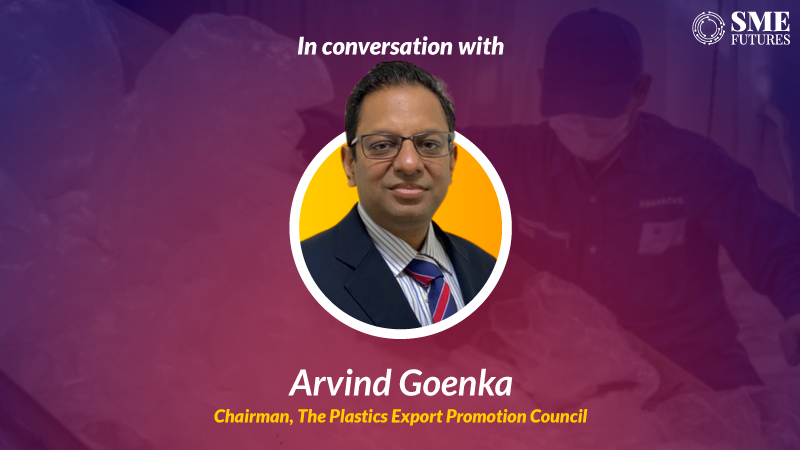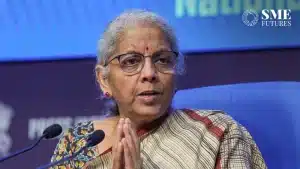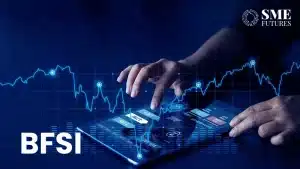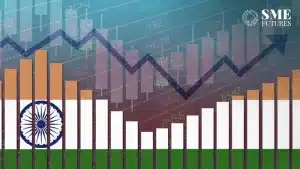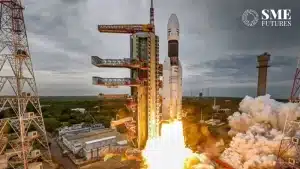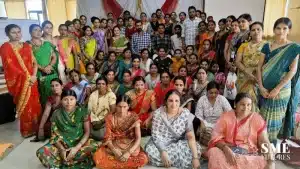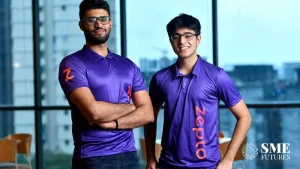The country’s plastic exports are expected to grow by 20-25 per cent in the current fiscal year on account of the favourable market conditions and increasing demand for domestic goods in key destinations such as the US and Europe. According to Plastic Export Promotion Council (PLEXCONCIL) Chairman Arvind Goenka, it should touch US$ 12 billion from US$ 9.5 billion in 2020-21. While during April-May this fiscal year, India exported goods worth about US$ 1 billion.
But even though the order books of exporters are healthy, government support is needed in certain areas to further push exports as the sector has a huge potential to create jobs. Moreover, the plastic export sector is facing some challenges like the inadequate availability and rising rates of raw material (polymers), increasing shipping freight, container shortages and an inverted duty structure due to certain free trade agreements.
Also, the sector is facing tough competition from China, as its annual exports from this sector are worth about US$ 70 billion. The U.S. and Europe account for about 50 per cent of the country’s total plastic exports. Thus, support from the government on these issues would help in enhancing the competitiveness of our domestic goods in the international markets.
At the same time, plastic consumption is increasing in India, and PLEXCONCIL has been advocating for the PLI scheme for the sector to boost manufacturing. “Consumption is increasing by 10 per cent, so actually India needs a petrochemical facility every year for the next 10 years to meet the demand,” says Goenka.
Discussing all these issues with SME Futures, PLEXCONCIL Chairman, Arvind Goenka shares some insights on the challenges and initiatives of this sector.
Edited Excerpts–
What is the present scenario of India’s plastics exports?
We would like to inform that India’s plastic exports have witnessed a decline in 2020-21, in line with the overall decline in the exports of the merchandise goods of the country.
However, the current year 2021-22 is turning out to be an exciting one for us. So far, the cumulative value of plastic exports during April 2021 – May 2021 was US$ 2,115 million as against US$ 1,400 million during the same period last year, registering a positive growth of 51.1 per cent.
At this pace, we feel that we should be able to achieve our 30 per cent growth target for the current year.

India’s import share in countries such as the UK, US, and ASEAN is less than 1 per cent. What are PLEXCONCIL’s initiatives to increase the presence of Indian goods in other regions? What immediate actions are required?
There are various initiatives that we are working on.
PLEXCONCIL has planned to hold several B2B meets (earlier physical), then we encourage Indian participation in overseas exhibitions, and mounting trade delegations post pandemic. The council is also actively engaging with Indian missions as well as international trade chambers of commerce for collaborations and promoting mutual business interest. The council has also planned to hold a reverse-buyer-seller meet (RBSM) early next year. We are happy to inform that the Government of India is revisiting the existing trade agreements and signing new trade agreements with other countries and regional blocks.
Talking about immediate actions; for the finished products of plastics to be competitively priced, we request that electricity costs should be lowered. For instance, take the case of China which offers 30 per cent cheaper electricity to Industry.
We also request for the removal of cross subsidy charges for power supplied to Industry. Logistics costs (exports in India are mainly dependent on road transportation) are high by at least 10 per cent as compared to that in the BRICS nations. In my opinion, this should be reduced. Also, polymer prices in India are higher by 10 per cent than the prices in China and this gap must be closed.
Please explain how the inverted duty structure poses a challenge and how the manufacturing and customs laws have affected the industry?
As you see, this is a challenge for us.
PVC resin and film have the same rate of duty and also, there are no initiatives to boost domestic manufacturing, thereby the cost of production is much higher. Similarly, Titanium Dioxide (Tio2) duty is high i.e., 29.8 per cent and that on the import of Masterbatches is low, thereby making domestic producers uncompetitive and there are no initiatives to increase their operations, thus making them expensive.
However, some initiatives have been taken to resolve these problems.
The implementation of the Customs (administration of rules of origin under trade agreements) Rules aka CAROTAR rules in India were a good initiative to start with, as it was aimed at plugging the import of goods diverted into India from 3rd countries where India has a trade agreement.
At the same time, faceless assessment by customs was another good initiative, which provides anonymity in assessment and helps in cutting the release time. In my opinion, there are some teething problems in the sector, however, the government has also been proactive in resolving them.
What are the COVID related challenges that the plastic export sector is facing? How has it affected the industry’s growth thus far?
The industry has been greatly affected after the outbreak of the pandemic. Firstly, polymer prices have increased and secondly, logistics costs have gone up steeply. Besides that, the availability of skilled manpower became a challenge after the end of the 1st & 2nd waves of the pandemic. Next, the non-availability of oxygen has also delayed expansion and growth plans, etc.
Having said that, I feel that the plastics industry was definitely affected but seeing the worldwide disruption in this sector, the effect in India was a tad less. However, we feel that the world economies will recover faster, and India may take longer, so the government must actively hear and resolve the manufacturer’s issues to enable them to keep pace with the changing dynamics.
PLEXCONCIL has been advocating for the PLI scheme to boost manufacturing. What is the status of the talks with the government and are there any latest developments on this front?
PLEXCONCIL has submitted data to the government, showing why the PLI and TUF schemes are important for the sector. In fact, all plastic associations, both individually and jointly with PLEXCONCIL have expressed the urgent need to boost polymer production in the country.
India’s polymer consumption is 20MMT and the production is just 15MMT, plus some polymers are exported. So, India imports more than 7MMT which is US$ 7 billion worth of polymers. Consumption is increasing by 10 per cent, so actually India needs a petrochemical facility every year for the next 10 years to meet the demand.
On the other hand, polymer producers do not find it very profitable and want the government to increase import duties before committing to CAPEX. If duties increase throughout the value chain, then it is acceptable to the processing industry but if duties are increased only on polymers, then it will not be in favour of the plastic processors. So, the best options are the PLI scheme for boosting polymer production and the non-imposition of non-tariff barriers or tariff barriers on the import of polymers in India.
Tell us more about the 50 product groups identified by the association and how they can help boost plastic exports.
PLEXCONCIL has identified 20 products that have an export CAGR percentage of above 25 per cent. They mainly consist of plastic films, FIBC & jumbo bags, medical disposable items, toys, optical items, houseware & plastic furniture, PVC leathercloth etc. We, as an export apex body are connecting with the industry (both members and non-members) to understand their difficulties and the trade barriers faced by them. Meanwhile, B2B exhibitions are also being held, focusing on these target product segments.
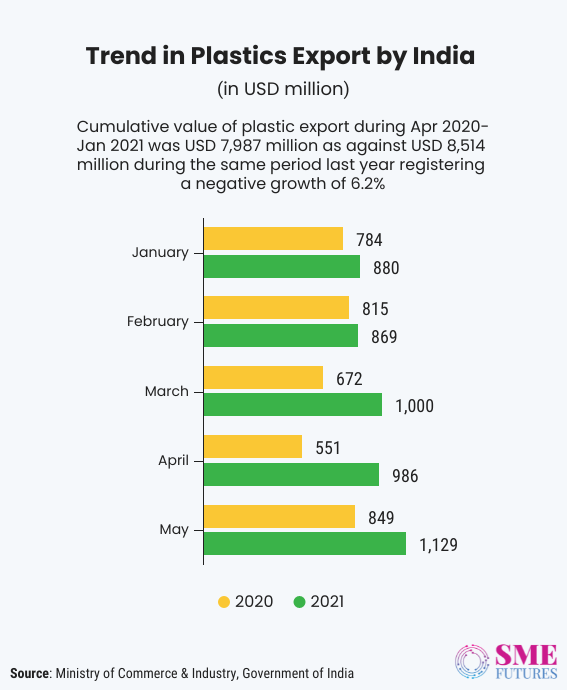
What is the future outlook or forecast for India’s plastic export sector?
The future is bright. Already for 2022, the sector is aiming at a growth of 30 per cent.
Currently, India has only a 1 per cent share in the world plastic exports segment. While China’s share in it is 7 times that of India. Considering this, there is a very large scope for growth. I believe that we won’t have problems to double or even triple it in the next 5 years. Before the pandemic had struck, PLEXCONCIL had targeted at exporting goods worth US$ 25 billion by 2025. We will be working in that direction.
However, there are still some small issues like no non-tariff barriers on polymer imports, a lack of clarity on RoDTEP (remission of duties and taxes on export products) rates and their applicability to AA holders and the non-availability of electricity at reasonable rates in the country. But the continuation of the betterment of the logistics infrastructure will ensure that plastics maintain their growth trajectory.

